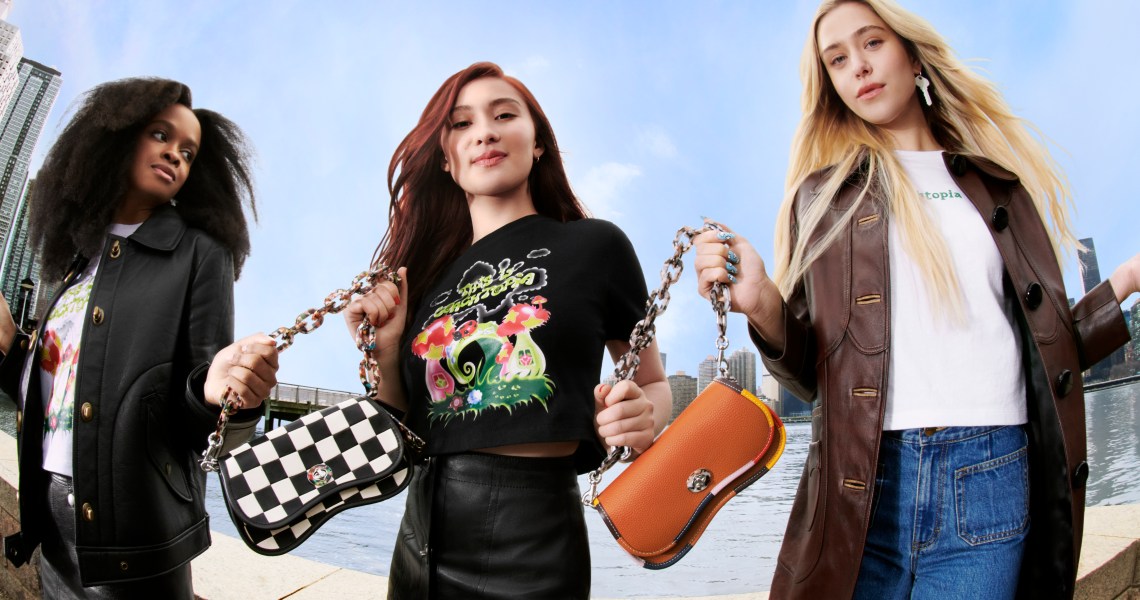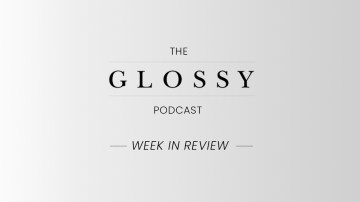This week, we take a look at Coach sub-brand Coachtopia, including the strategy behind it and what sustainability experts are saying. Scroll down to use Glossy+ Comments, giving the Glossy+ community the opportunity to join discussions around industry topics.
Coach’s new sub-brand, Coachtopia, is focused on products for a Gen-Z audience with circularity embedded from the design stage. It has dedicated TikTok and Instagram accounts, as of April 18, and its debut collection has already sold out twice. But is it as good as it seems?
Coachtopia officially launched on April 21, on Coach’s website, in its North American stores and in Selfridges’ sales channels. Out of the gate, styles included six bags, one card case, one hoodie, three styles of T-shirts, a pair of sandals, sticker sets, keychains, bag handles and four clothing items made from repurposed denim.
Created with a cohort of 120 circular influencers, spokespeople and educators dubbed “Coachtopians”, the sub-brand leverages a new model of community co-creation through social media. The main difference from the core Coach line is that Coachtopia’s main purpose is to test circularity for commercial success. Its future product drops will also be built with circularity in mind. The 82-year-old Coach brand specializes in handbags and leather accessories, and reported $4.9 billion in 2022 revenue.
Apart from featuring circular design elements, such as recycled or up-crafted leather and denim, all Coachtopia products were designed to be taken apart at the end of their life. Digital wallets are integrated by product digitization platform EON, which also works with Chloé and Mulberry. The wallets provide end consumers with detailed information on an item’s composition and care, plus track the item over the course of its life, from owner to owner. Each item’s wallet is scannable through a tag that links to the corresponding product page featuring the information.
According to Coach sources, what partially motivated Coachtopia’s launch was TikTok and its culture of exposing brand practices. In August 2021, Anna Saks, an anti-waste TikToker, made a video showing several slashed Coach bags that she found while dumpster diving by one of its stores. Fueled by negative press and the TikTok community, the video, which currently has 5.8 million views, showed the power of social media to drive the brand waste conversation.
Coach had already been working on its waste issue. In April 2021, coincidentally, the brand launched Coach (Re)Loved, a collection based on upcycled pre-loved bags. In the two years since, Coach has upcycled 20,000 bags, according to the company. Coachtopia expands those efforts with its exercise involving education, marketing and a focus on Gen-Z sales.
Coach’s production scale
The leather industry is mired with misinformation around its environmental impact, production costs and size, so it benefits brands in the space to offer transparency and traceability. As with other fashion categories, many young conscious consumers look to knowledgeable TikTokers to gain clarity on the claims of leather goods brands.
That includes Volkan Yilmaz, known on TikTok as Tanner Leatherstein (798,000 followers). A creator focused on leather products, Yilmaz has over 20 years of industry experience. In his videos, he cuts up and burns leather handbags by brands including Louis Vuitton and Coach to determine their quality. Some of his Coach bag reviews, which have mostly rated its leather as excellent, have 9.5 million views. Yilmaz has not yet reviewed a Coachtopia product.
Where Yilmaz has critiqued Coach has been around its scale. “After I started making these videos, tanneries in places like Germany started reaching out to me. One said they’ve been making leather for Coach for 30 years and that bag I was cutting was made with their leather,” he said. “At some point, that tannery was making 40-50 million units of leather products [for Coach] per year, which is an insane amount of production.”
While Coach is tackling its waste problem, a bigger issue it has not addressed is overproduction. Steven Bethell, founder of wholesale reseller Bank & Vogue and board member of non-profit Accelerating Circularity, said in a recent The Industry.Fashion interview that most brands are not aware of the rate of their overproduction. Knowing where items go after being sold for wholesale is important. Bethell collects data on what items are going where to help brands reduce overproduction and increase circularity. Bethell sells over 3 million used clothing items and accessories per week.
Coach declined to disclose its production numbers. The brand, owned by the multinational luxury holding company Tapestry, has contributed greatly to the company’s forecast revenue for 2023, set to be $6.6 billion. Production quantities for its $100-$600 bags must be significant. However, tackling overproduction is at odds to keeping shareholders happy.
How Coachtopia plays into commercializing circularity
Enter: Coachtopia. “Ultimately, the goal of Coachtopia is to transform Coach into a fully circular business model,” said Joon Silverstein, Coach’s svp of global marketing, creative and sustainability, and head of Coachtopia. “The learnings of Coach (Re)Loved and Coachtopia around making the system scalable will feed back into Coach again, creating this mutual ecosystem of progress.”
She added, “We have implemented this continuous feedback loop.” That includes social listening and feedback from the Coachtopians, who work with the brand for free, as well as sales and customer response. All are collated as data for improving future launches. Coachtopians include Lola Tung, an actress known from Amazon series “The Summer I Turned Pretty”; climate activist Aditi Mayer; graphic designer Sabrina Lau; and Natalia Spotts, a secondhand boutique owner.
The sub-brand’s social media channels on TikTok and Instagram will build on existing leather education on Coach’s website, tailoring it for younger consumers. Its Instagram account currently has 10,000 followers, and its TikTok has 2,000.
The billion-dollar question is whether Coach can make circularity scalable and commercially successful, and set a replicable example for other brands.
Is the marketing spend for Coachtopia excessive?
For brands, marketing and launches go hand in hand, but that becomes more complicated when addressing sustainability and circularity. How much marketing is too much, when investment is needed elsewhere to scale involved technologies?
“Already, because of its scale, Coach has been able to implement larger solutions to bigger problems [around sustainability], without doing any marketing really around it at all,” said an ex-employee and leather expert who requested to remain anonymous. “They introduced regenerative leather two years ago, and it’s hard to even find [mention of] it on the website.”
On the flip side, while the brand declined to disclose the marketing spend for Coachtopia, it reads as excessive. Thus far, that’s included investments in social ads and content, and a dedicated pop-up shop. The brand is encouraging a young demographic to shop by focusing on a new launch of products and their style, rather than supporting sustainable production just through education. Most of the comments on Coachtopia’s TikTok videos lament that styles are sold out and ask where the bags can be bought globally.
“It’s a super-fine line for brands to walk between nailing a new circularity concept and going all out with a marketing effort that overplays the impact it will have,” said Rachel Arthur, founder of sustainability-focused community platform FashMash and advocacy lead for sustainable fashion in the UN Environment Programme. “What this is ultimately about is getting consumer buy-in for circular solutions that are [truly] above and beyond what they would otherwise buy.”
Responding to an April Global Voices survey by DTC tech company ESW, 64% of Gen-Z respondents said they’ve spent more on a product because it was sustainable. Considering greenwashing among fashion brands remains rampant, whether their money is being well-spent is uncertain.
“Scalable solutions are more important than the marketing opportunity in these craft projects,” said the ex-employee and leather expert. “If you want to make a real impact on your business [with a sustainability initiative], then you’re going to have to have a scalable solution and it also has to be profitable.”
Inside our Coverage
New Gen Z-centered app RTRO launches with ChatGPT and focus on messaging
Exclusive: Coty launches employee-focused metaverse space Coty Campus
Want to discuss this with our editors and members? Join here, or log in here if you're already a member.




